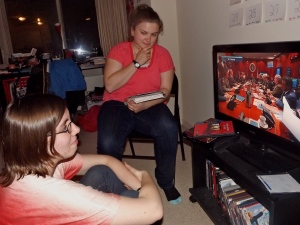The following blog post was written by UHPer and SURE Award winner Jane Meiter.

The first time I rode the elevator to the third, restricted floor of the Smithsonian National Museum of Natural History, I didn’t know what to expect. The countless rows of locked metal cabinets, twisting to form a labyrinth of specimens, were not quite what I expected.
When I came to GW, I knew one advantage of the school was its proximity to the Smithsonian. I never imagined that by the fall of my Sophomore year I would be accepted inside of its hidden domains. For the last year I have held a research assistantship through the Honors program where I go to the National History Museum’s backstage areas and 3D scan mammalian bones. As an anthropology student, this opportunity exceeded my wildest dreams for how I would be spending my Fridays throughout the semesters.
3D scanning is a critical advancement in the science of biological anthropology. One of the difficulties in making measurements of bones is in the exact variations of such complicated three-dimensional shapes, so portable 3D scanners have made such measurements more precise and accessible. My research assistantship focused on building a database of African bovid postcrania. In English, my job was to select adult skeletons of African bovids—think gazelle, water buffalo, wildebeest—identify the bones, and scan them. This requires accurate bone identification, including the side of the body it comes from. Practicing week after week identifying bones helps solidify my knowledge of skeletal anatomy. Once I have selected the bone to scan, I take it to the rotating turntable, placed in front of the glowing, striped blue light of the scanner. The portable scanner is the size of a thick book, laid on top of a tripod, the camera staring out from where the spine should be, and a handle molded into the back of the scanner. A computer program controls both the scanner and the turntable, so the scanner takes a picture and the turntable rotates in sync, repeating until the turntable has gone all the way around. The software renders the photos of the bone into a 3D image. Sometimes, there are particularly exciting days, like the two weeks where I was scanning the colossal bones of wildebeest. Their ankle bones are the size of my palm and I had to swap to the hand-held mode of the scanner, swinging it wildly over the larger bones, standing on my tiptoes in order to keep it far enough away to register the scan.
This research assistantship has been an invaluable and integral part of my GW experience. Without it I would have never been presented with such an opportunity to see the Smithsonian Institution behind the scenes and to encounter such a diversity of learning material outside of the classroom. Every time I enter the now-familiar labyrinth of cabinets, I still never fail to be amazed by the scale of it all.

 Traveling during the holidays gave me an intimate lens into the lives of local people who hosted me during my stay. I was welcomed warmly into the homes of many families who treated me as a member of their family during their holiday celebrations. I spent New Year’s Eve in the divided city of Mostar, in an unheated house with an older couple. Together, we huddled under blankets and had a long, wonderful conversation despite not speaking more than a few words of each others’ language. A week later, I spent Orthodox Christmas with a family in East Sarajevo. We ate roast lamb for breakfast, then I lay around watching the Kardashians with the family’s two teenage daughters.
Traveling during the holidays gave me an intimate lens into the lives of local people who hosted me during my stay. I was welcomed warmly into the homes of many families who treated me as a member of their family during their holiday celebrations. I spent New Year’s Eve in the divided city of Mostar, in an unheated house with an older couple. Together, we huddled under blankets and had a long, wonderful conversation despite not speaking more than a few words of each others’ language. A week later, I spent Orthodox Christmas with a family in East Sarajevo. We ate roast lamb for breakfast, then I lay around watching the Kardashians with the family’s two teenage daughters.




